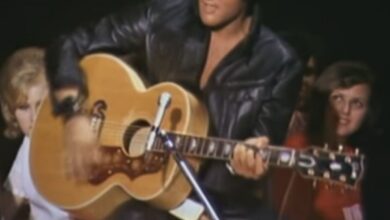Hear This: The One Man Who’s Been Gone 40 Years And Still Leaves You Breathless
“Trying to Get to You” exemplifies Elvis Presley’s unique ability to blend emotion with musicality, a hallmark of his long-standing career. The song itself, which dates back to the early 1950s, has gone through various interpretations over the years. Initially recorded by the Eagles, the song represents the spirit of yearning and determination. However, it was Elvis’s rendition that truly transformed the piece, infusing it with his characteristic rock and roll flair and an intense emotional depth that resonated with listeners.
The ’68 Comeback Special marked a pivotal moment in Elvis’s career. Following years of declining popularity in the music scene, this televised event re-established him as a force in the entertainment industry. His performance of “Trying to Get to You” during the special is often cited as one of the standout moments. It not only showcased his vocal prowess but also highlighted his charismatic stage presence. Elvis’s connection with the audience was palpable, drawing viewers into the narrative of longing expressed in the lyrics.
As the performance unfolds, Elvis starts with a soulful delivery, his rich baritone gently pulling the audience into the song’s emotional core. The introduction serves as a canvas for his vocal range, displaying a softer, more vulnerable side before building into the powerful chorus. This dynamic switch is a signature aspect of his artistry, illustrating how he could convey deep emotional landscapes through his singing. As he transitions into the more upbeat and rock-influenced parts, the arrangement becomes a delightful showcase of musical interplay, driven by rhythmic guitar riffs that highlight the fun, energetic vibe of rock and roll.
The full effect of Elvis’s performance lies not just in his voice but also in the visual elements and stage presence he brought to the ’68 Comeback Special. The black leather outfit he donned became iconic, symbolizing a bold return to form for the artist. His physicality on stage, with fluid movements and commanding gestures, captivated audiences, adding layers of meaning to the lyrics he sang. This combination of sound and spectacle was critical to the power of the performance, making it memorable beyond just the music itself.
Elvis’s ability to connect with his audience extended beyond mere performance. His expressive facial expressions and small gestures conveyed the longing embedded in the lyrics. For many, these moments of connection with the audience characterized the best of what live music can offer. His evident passion for the song, coupled with an innate theatricality, captured the hearts of those watching and listening, solidifying the impact of his performance.
The song’s lyrics express an intense commitment and yearning for a loved one, a theme familiar and relatable to many. It taps into universal feelings of desire and pursuit, making it timeless. Elvis’s approach added a personal touch, transforming the song into something that felt intimate and profoundly sincere. His interpretations often made listeners feel as though he was telling their own stories, a testament to his extraordinary ability to channel human emotion through music.
Elvis Presley himself was a figure of immense cultural significance. Born on January 8, 1935, in Tupelo, Mississippi, he rose to become a global icon in music and film. His blend of country, blues, and gospel created a revolutionary sound that redefined popular music in the mid-20th century. He was often referred to as the “King of Rock and Roll,” and his contributions to the genre have had a lasting influence on musicians across many genres.
In addition to his musical talents, Elvis was also known for his charisma and infectious energy. He influenced fashion trends, cultural norms, and the very landscape of modern entertainment. Throughout his career, he sold millions of records, starred in numerous films, and won multiple awards, including three Grammy Awards. His legacy continues to inspire artists and fans alike.
While “Trying to Get to You” may have been just one of many songs in his catalog, it encapsulates everything that made Elvis Presley a legend. The emotional intensity, combined with the excitement of rock and roll, showcased his ability to reinvent songs in a way that left an indelible mark on music history. The live performance was not just a moment in time but rather a reflection of the artistic reinvention that defined his career in the 1960s.
The ’68 Comeback Special and its performances, including “Trying to Get to You,” are celebrated as a resurgence of creativity and passion for Elvis. They provided a platform for him to reintroduce himself to a new generation of fans while reinforcing his status as a timeless artist. The excitement and allure of his performances continue to inspire musicians today, underscoring the profound impact he had on the world of music.



